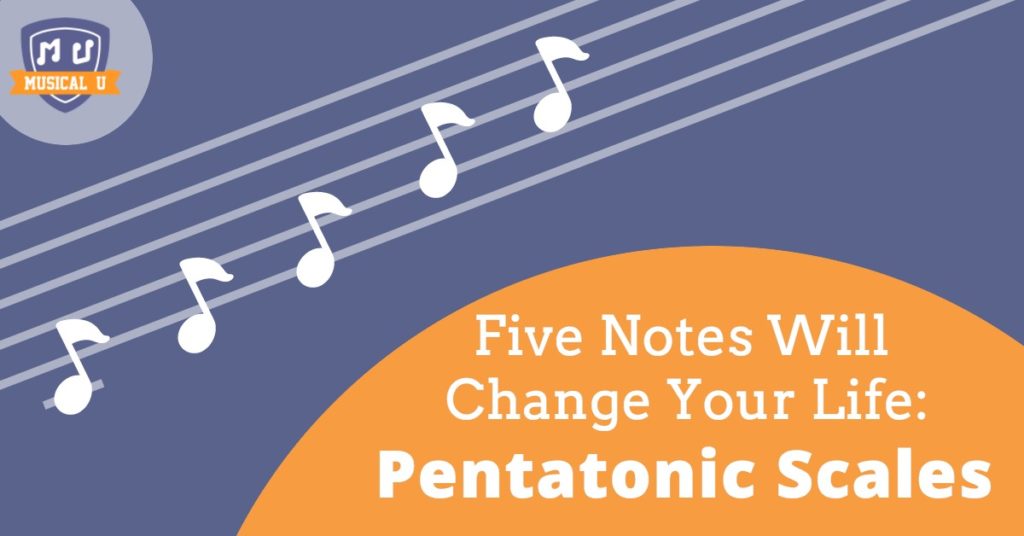Major scales, natural minor scales, harmonic minor scales, melodic minor scales, chromatic scales, diminished scales, Lydian augmented scales… Scales, scales, scales! Just how many scales do we really need to know?
What if there was one scale to rule them all?
Well, there is one scale that – while it may not rule them all – is by far the most useful.
Hint: it’s not the major scale!
This is a scale that’s been around a long, long, time – maybe even the first scale ever grunted out by proto-humans way back in history. This scale, found in virtually every culture in the world, is the pentatonic or five-note scale, existing in major and minor forms. And despite its ancient origins, the pentatonic scale is as fresh and new and useful today as it has ever been.
This part of the Start Solfa lesson series, will explore the pentatonic scale and its countless uses. By the end of this lesson, you’ll understand how to build the pentatonic scale in any key, and layer it over chords and other scales – a useful foundation for later lessons.
Solfa and the Pentatonic Scale
In previous parts of the Start Solfa lessons so far, we’ve covered the basics of finding “do” and applying solfege syllables in a given key, as well as singing and hearing intervals. Now, we will look at the major and minor pentatonic scales, and see how the intervals in these scales can help us recognize even more patterns in simple melodies.
Solfa syllables will be your best friend in remembering and being able to recall the distinct intervals used in the major and minor pentatonic scales.
What is a Pentatonic Scale?
By definition, a pentatonic scale contains five pitches per octave. For the purposes of this article, we will focus on major pentatonic scales, which contain the five most commonly used pitches in simple songs and folk melodies, and on the minor pentatonic, which is also found across different styles of music. To derive the major pentatonic scale from the major scale (we’ll get to the minor later), simply remove the 4th and 7th degrees, which leaves you with five notes per octave.
A major pentatonic scale consists of a series of intervals starting from do:
- Do-Re
- Do-Mi
- Do-So
- Do-La
- Do-Do
Therefore, the pentatonic scale degrees are 1, 2, 3, 5, and 6. If we sing a major pentatonic scale, it will sound like this, containing the notes C D E G A C:

The pentatonic scale has a very distinct, pleasant sound that works great layered over many chords and other scales. As stated above, it contains the most commonly used pitches in many popular songs. Its lack of half-steps contribute to its distinct sound, as compared to a major or minor scale.
There are countless songs that use the pentatonic scale exclusively; with a quick Google search, you can find a vast number of tunes using the pentatonic scale. Check out this list of songs at Beth’s Music Notes. And if you need more persuasion that this scale has a special significance, just watch this fun video demonstration of the pentatonic scale by Bobby McFerrin:
So why does the pentatonic scale sound good?
Let’s look into precisely what makes the pentatonic scale so universally pleasant-sounding and easy to layer over chords and other scales.
In a major scale, the fourth and seventh degrees form a tritone. This interval introduces tension and suspense to the scale.

Now, let’s look at the notes involved in the pentatonic scale; the fourth and seventh degrees are missing! The tritone is therefore absent from the pentatonic scale, and the tension and suspense disappears from the scale:
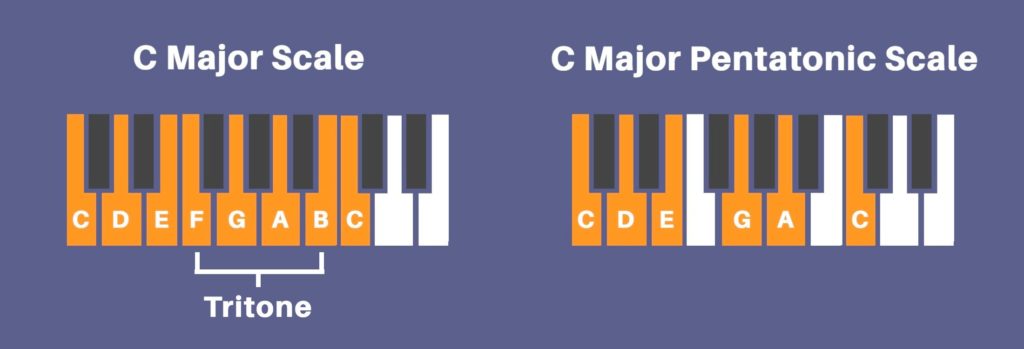
Here’s another way of looking at it: the major seventh and to some extent the perfect fourth intervals are considered to be dissonant in a major scale. Look at the intervals in a pentatonic scale, and going up from the root note you’ll find a major second, major third, perfect fifth, and major sixth.

Both the perfect fourth and the major seventh are omitted in the pentatonic scale, leaving only consonant intervals!
Pentatonic vs. Major
By comparison, the major scale – the scale that we first learn and which “seems” to be the basis of everything – only became popular in the beginning of the 1600s. Let’s have a look at how the major scale compares to the pentatonic.
Each major scale step can be numbered by degrees:
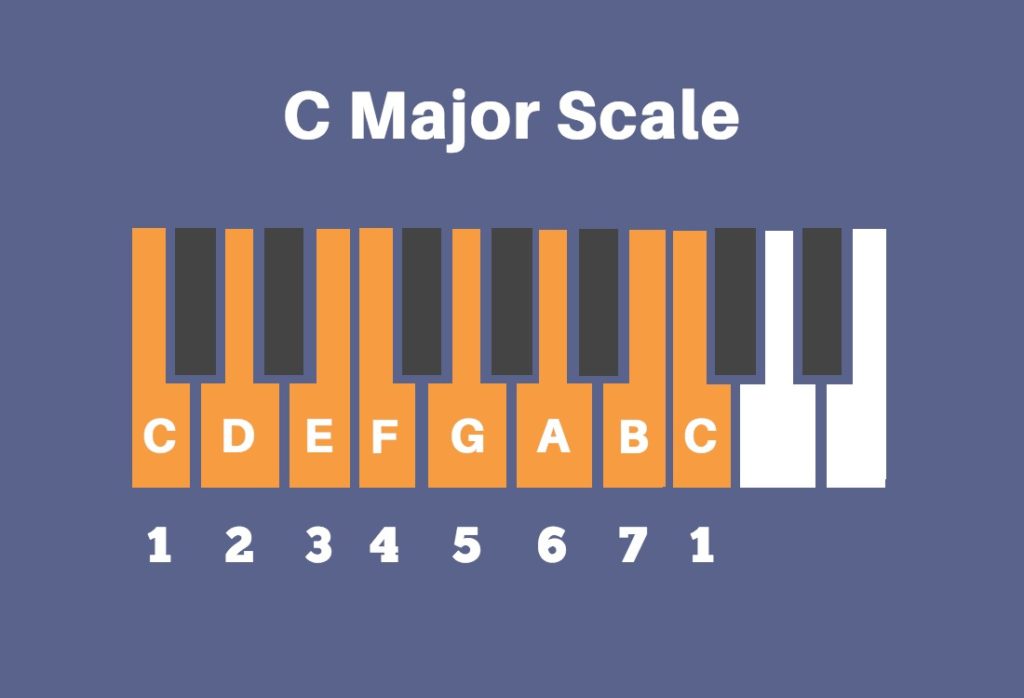
For the major pentatonic scale simply remove the fourth and seventh degrees:
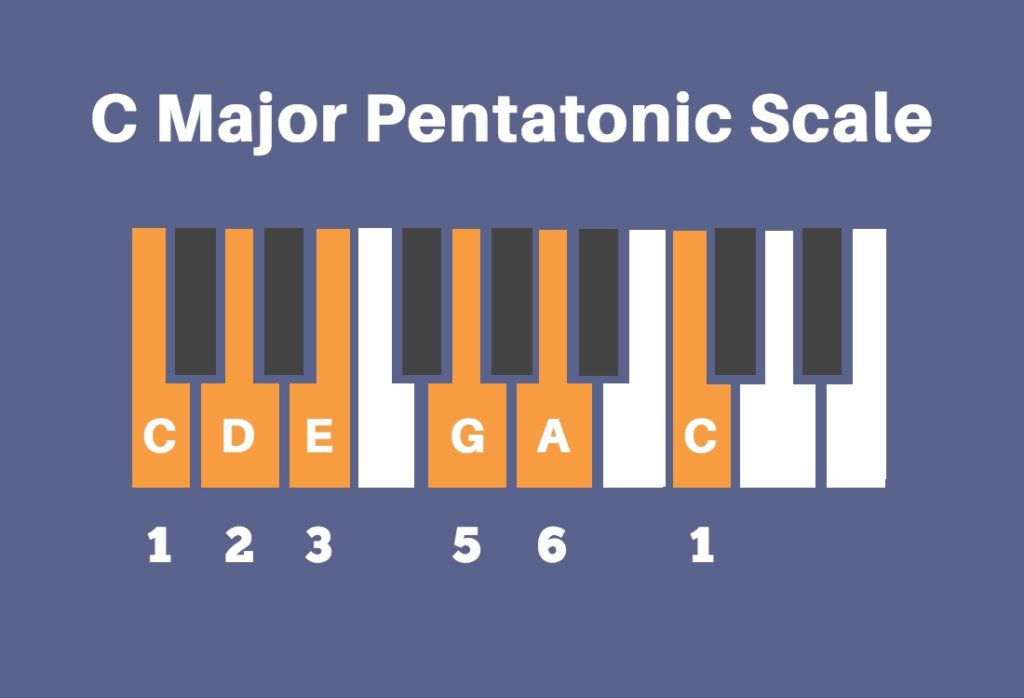
One of the best ways we can understand this musical powerhouse is through another old system (although not quite so much – it dates to the Middle Ages) – the solfa syllables (aka solfege):
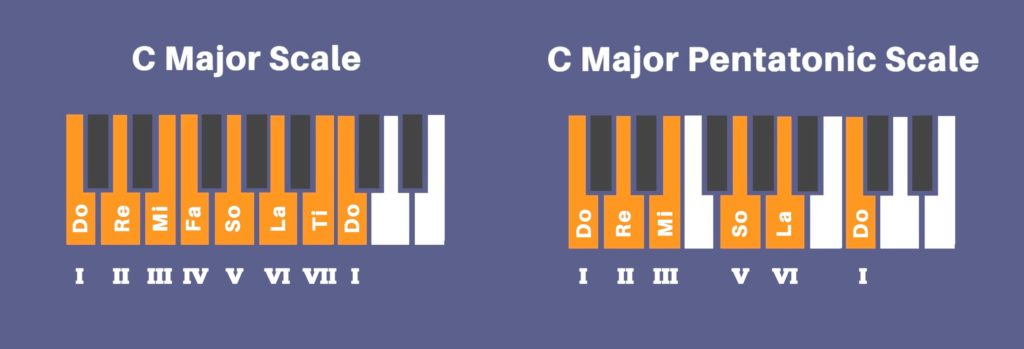
Omit “fa” and “ti” and you transform the major scale into a pentatonic scale. Add them back in to a pentatonic and you’re back to the major.
Where does the pentatonic scale come from?
Though it’s commonly used in modern music, the pentatonic scale is a senior citizen in the world of music; musical instruments believed to be 50,000 years old were found to be tuned to the pentatonic scale!
Another reason the pentatonic scale is thought to be an early development in Western music is the ubiquity of it throughout various epochs in music. Early Gregorian chants contained pentatonic melodies, and pentatonic scales in various forms are found in traditional Native American, African, and South Asian music. Regardless of the musical era, it’s hard to avoid running into the pentatonic.
Who Uses Pentatonic Scales Now?
The musical concepts of this traditional and folk music formed the basis of genres such as jazz, gospel, and bluegrass, as well as modern folk music. As these styles evolved into modern blues and rock, the pentatonic scale remained as an integral part of those genres.
Today, it’s as ubiquitous as ever, and for good reason; the pentatonic scale offers a fantastic improvisational framework for blues, rock, and beyond! In modern jazz, you’ll often hear amazing pentatonic solos whipped out by pianists, flautists and saxophonists.
The Pentatonic Scale in Modern Rock Music
The popularity of the pentatonic scale in rock and blues is justified, considering how great it sounds with almost everything: dominant seventh chords, minor or major scales, church modes, and more. Soloing with the pentatonic scale over chord progressions is very common in rock, and is an excellent exercise for beginner musicians to start improvising rock solos quickly. In particular, the minor pentatonic is an indispensable part of Blues improvisation – beginner guitarists are often taught the minor pentatonic earlier rather than later because it’s versatile and relatively simple to play.
What Can You Do With the Pentatonic Scale?
A quick refresher: the major pentatonic scale contains five notes instead of the usual seven per octave, with the 4th and 7th degrees of the major scale removed.
So, you may ask, if it’s just a “condensed” major scale, why use the pentatonic scale at all?
Turns out, the subtraction of these degrees is exactly what gives the pentatonic its power. Here are just some of the reasons you will want to use it – you will later discover even more uses as you experiment with the scale.
1. Versatility in improvisation
You can play the pentatonic scale over a major chord progression – but also a minor chord progression, or a classic 12-bar blues progression. Because its notes are all consonant, it sounds good over nearly everything; try playing the pentatonic scale over a backing track, and you’ll see what we mean!
2. Easy To Play
Memorize certain patterns on your fretboard and keyboard, and you can easily transpose them into any key; see our pentatonic scale tabs below.
3. Play over modes
The church modes are either major or minor. The major modes are Ionian, Lydian, and Mixolydian, and all contain scale degrees 1, 2, 3, 5, and 6. In other words, the major modes all contain a major pentatonic scale, making it a perfect scale choice for writing or improvising in these modes, or playing over a modal backing track.
Singing the Pentatonic Scale
To really internalise the sound of the pentatonic scale you’ll want to practice singing it. Don’t worry if you’re not “a singer”! Start with our lesson on how to sing in tune.
The solfa syllables for the pentatonic scale are Do-Re-Mi-So-La-Do. Sing along with the clip below:
Now we will sing up and down the pentatonic scale, singing Do-Re-Mi-So-La-Do, Do-La-So-Mi-Re-Do.
Now try singing the pentatonic scale without the audio clip. Can you produce the correct pitches without singing along with someone else?
A good method for practice is to record yourself and play it back. A tool like Voice Memo on iPhone or Audacity is helpful for this – see our Audacity article for step-by-step instructions. Sometimes your brain will trick you into thinking you’ve sung something correctly, but recordings never lie. Compare your recording with the given audio clip above, and see if you can match it yourself.
Playing the Pentatonic Scale
The beauty of this scale is how easy it is to play it, once you know the general pattern. Because it’s so ubiquitous and useful in blues and rock soloing, we’ll show you the pentatonic scale shapes as they appear on the keyboard and the fretboard.
The Pentatonic Scale on Piano
Try this: start on F#, and play a scale on black keys only, ascending. What does it remind you of?
We’re guessing you can hear a distinct Oriental feel in the scale you just played, reminiscent of traditional Asian music.
You have actually just played a major pentatonic scale! The F♯ major pentatonic scale, to be precise. The pentatonic scale is often found in synth lines or keyboard parts in modern music; electronic artist Grimes’ song “Genesis” is played in F♯ major, and in fact uses the ascending F♯ major pentatonic scale as embellishment on the synthesizer, starting at [0:12]:
The pentatonic scale is very commonplace in piano music in general, as a quick browse through sheet music can show. Seasoned piano players: you may have already realized that you can also play “Amazing Grace” by only using the black keys on the piano, as this song is also built on a pentatonic scale! “Swing Low, Sweet Chariot” is yet another song you can play with just these five notes. Give it a try!
To play the pentatonic scale in any key simply requires you to memorize and apply the scale degree sequence of pentatonic scales.
Remember: the pentatonic scale degrees used are 1, 2, 3, 5, and 6; this never changes, regardless of key! If you have a known chord progression, you can use chord mapping to determine which key you can play a pentatonic scale in to effortlessly solo over the progression, and avoid hitting the wrong notes, regardless of key changes.
The Pentatonic Scale and the CAGED System for Guitar
There are five common patterns for the major pentatonic scale, as we show below on the fretboard diagrams. Known as the CAGED box forms, each pattern is named for one of the five open major chord shapes: C, A, G, E, or D.
Take a look at the five ways to play a major pentatonic scale, and see if you can spot the open chord that each is built around!
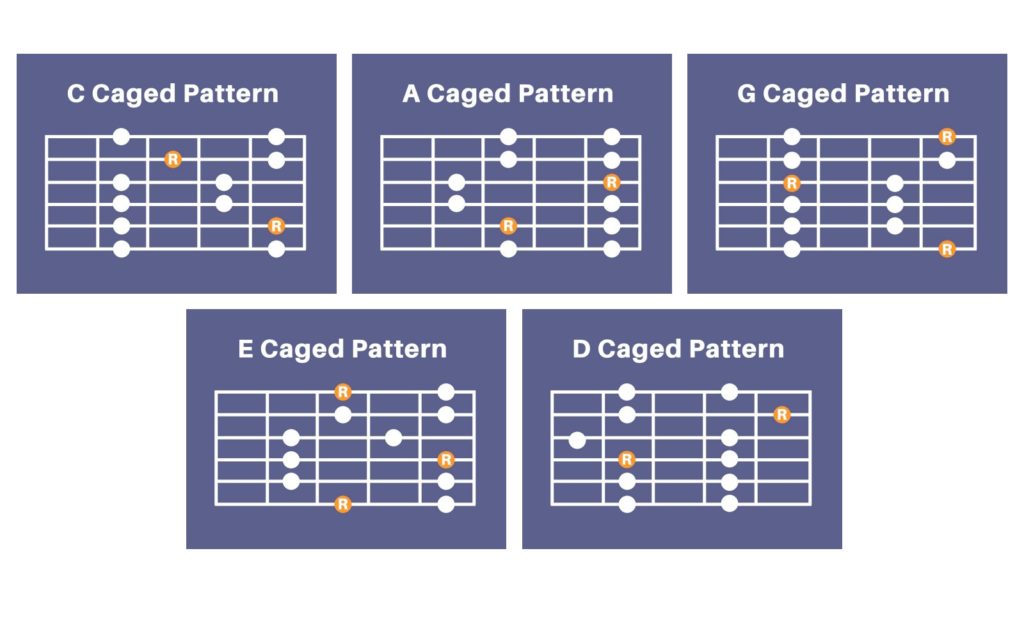 These patterns are the key to unlocking the power of the pentatonic scale on your guitar. Once you have the patterns down, you can simply move them up or down the fretboard to transpose the pentatonic scale into a different key. To practice pentatonic scales most effectively, try mixing up the pattern and key you are playing in!
These patterns are the key to unlocking the power of the pentatonic scale on your guitar. Once you have the patterns down, you can simply move them up or down the fretboard to transpose the pentatonic scale into a different key. To practice pentatonic scales most effectively, try mixing up the pattern and key you are playing in!
Hearing Pentatonic Scales
One advantage of pentatonic scales is that there are only five different pitches (or six if you’re counting the octave above the tonic). When trying to recognise the scale in a piece of music, you will find you can identify this scale with relatively little information – you can recognize it based on the number of pitches, since other types of scales have more notes. However, it is worth using a tool like this one from Teoria.com, because if you can pick out the pentatonic scales from major scales, you will have a great advantage further down the line. To use the exercise, be sure you tick the box next to “Pentatonic Scales”, along with “Major minor”. If you already know major and minor scales, you can try to identify these as well. Challenge yourself to hear the difference between pentatonic and other types of scales.
You can also try playing the scale on your instrument, to get used to the sound of these five notes. Remember, because you know the solfege, you can play a pentatonic scale in any key where you know the major scale. Just use the Do-Re-Mi-So-La-Do notes!
For example, a pentatonic scale starting on D would be:

Here’s the scale in G:

And F:

Beyond the Major Pentatonic
The major pentatonic scale is a common and useful scale that is excellent to learn for beginners, as it gets you used to the pattern of notes, and gets you on your feet and playing quickly. Once you’ve nailed down the major, it’s time to explore further…
Minor Pentatonic Scales
If you know major pentatonic scales, it’s very easy to derive minor pentatonic scales.
In the same way that each relative minor scale contains the same notes as its corresponding major scale, the minor pentatonic scale will have the same five notes as its major cousin – it will just start on a different note, meaning the minor pentatonic scale degrees will be 1, 3, 4, 5, and 7 of the minor scale.
A refresher: the first degree (tonic) of the relative minor scale of any major key is found three semitones down from the tonic of the major scale. For example, the relative minor pentatonic scale of C major will be the A minor pentatonic scale, with the notes A C D E G A. If you’re familiar with the Circle of Fifths, you can easily use the tool to find your relative minors.
The minor pentatonic scale is well worth learning after you master the major pentatonic scale. It’s used in pop, rock, country, metal, and beyond. It’s another perfect beginner scale for soloing with.
If you want to whip out beautiful blues solos, the minor pentatonic scale is a must-have tool you’ll want in your arsenal, along with the major and minor blues scales. Blues and the minor pentatonic scale go together like bread and butter.
Similar to how you can use the major pentatonic to solo over major modes, the minor pentatonic can be used to solo over some of the minor modes – Dorian mode, Phrygian mode, and Aeolian mode all contain notes found in the corresponding minor pentatonic, making it a great soloing tool to complement these modes.
Permutated Pentatonic Scales
Yes, “pentatonic scale” does most often refer to the generally popular major and minor pentatonic scales. However, you’re not limited to just those two.
Think about it: the only real “requirement” of a pentatonic scale is the presence of five notes per octave. Therefore, there are thousands of possibilities of permutation!
Once you master the major and minor pentatonic scale, experiment with changing up some of the notes. You can even derive your own pentatonic scales from modes, by including the trademark intervals of that mode!
Pentatonic Scale Cheat Sheet
Want to pick up your instrument and get playing as fast as possible? Here’s some good shortcuts that’ll get you playing the major and minor pentatonic within seconds!
Major Pentatonic Scales
Let’s look at the C major pentatonic scale first. The notes used will be Do, Re, Mi, So, and La; in other words, C, D, E, G, and A, as we show below:
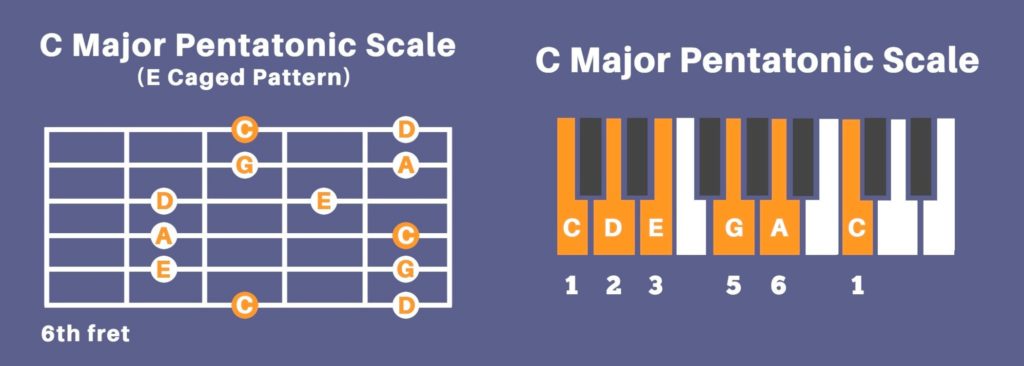
Now let’s look at the notes in the remainder of the major pentatonic scales in each key. Notice that the notes used fit with the unique key signature of each key:
C♯ Major Pentatonic scale: C♯, D♯, F, G♯, A♯
D Major Pentatonic scale: D, E, F♯, A, B
E♭ Major Pentatonic scale: E♭, F, G, B♭, C
E Major Pentatonic scale: E, F♯, G♯, B, C♯
F Major Pentatonic scale: F, G, A, C, D
F♯ Major Pentatonic scale: F♯, G♯, A♯, C♯, D♯
G Major Pentatonic scale: G, A, B, D, E
A♭ Major Pentatonic scale: A♭, B♭, C, E♭, F
A Major Pentatonic scale: A, B, C♯, E, F♯
B♭ Major Pentatonic scale: B♭, C, D, F, G
B Major Pentatonic scale: B, C♯, D♯, F♯, G♯
Minor Pentatonic Scales
The relative minor of C major is A minor. Therefore, the relative minor pentatonic scale of the C major pentatonic scale will be the A minor pentatonic scale!
The notes used in the minor pentatonic will be La, Do, Re, Mi, and So, or A, C, D, E, and G:
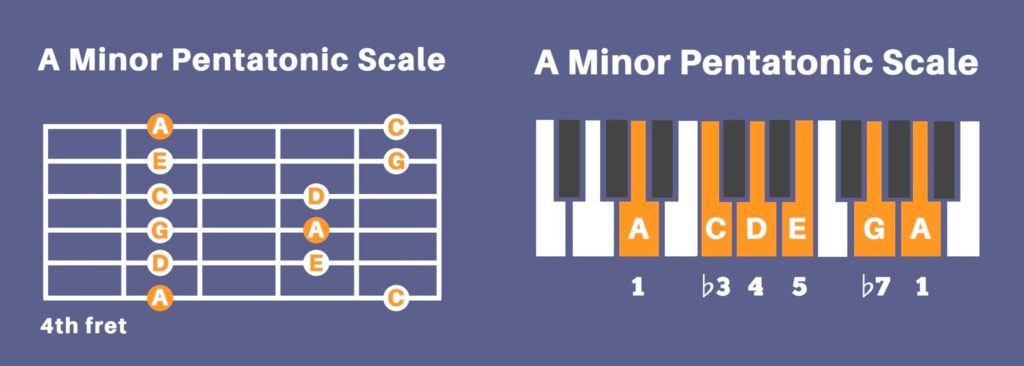
Notice that the A minor pentatonic scale is the relative minor scale of C major pentatonic, and therefore uses the same notes, but starting on a different pitch. This is true for every minor pentatonic in its relation to its relative major pentatonic.
Here are the notes used in each different key of the minor pentatonic:
B♭ Minor Pentatonic scale: B♭, D♭, E♭, F, A♭
B Minor Pentatonic scale: B, D, E, F♯, A
C Minor Pentatonic scale: C, E♭, F, G, B♭
C♯ Minor Pentatonic scale: C♯, E, F♯, G♯, B
D Minor Pentatonic scale: D, F, G, A, C
E♭Minor Pentatonic scale: E♭, G♭, A♭, B♭, D♭
E Minor Pentatonic scale: E, G, A, B, D
F Minor Pentatonic scale: F, A♭, B♭, C, E♭
F♯ Minor Pentatonic scale: F♯, A, B, C♯, E
G Minor Pentatonic scale: G, B♭, C, D, F
A♭ Minor Pentatonic scale: A♭, C♭, D♭, E♭, G♭
Five Notes to Rule Them All
With its myriad of uses and its special place in nearly every genre of mainstream modern music, the general usefulness of the pentatonic scale (both major and minor) cannot be overstated. Learn its patterns on your instrument, and most importantly, practice singing along with solfege syllables to cement the pitch pattern. Pay attention to both the major and minor pentatonic, as they both have their unique uses. Producing the scale with the corresponding solfege helps connect the sounds of each scale degree with a syllable, making it more likely that you will instantly recognize the notes of a scale because your brain will process them based on their solfege identity.
Now that we’ve learned about intervals and the pentatonic scale, it’s time to move on to chords. Chords are the basis of harmony, and for anyone interested in improving their ability to hear harmony or improvise harmonies with melodies, hearing chords is vitally important. Please do check out the next part in this lesson series to go even further with solfa!

